Optimus 8R
The 8R has been discontinued. If you're looking for something new, check out the best liquid fuel stoves for 2025.
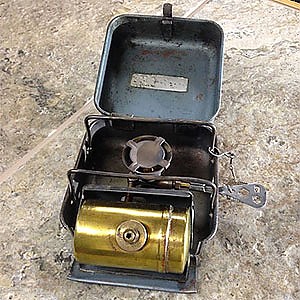
I currently own a number of vintage Optimus and Primus stoves. I have been around them and used them since the early '70s, camping with my family. I bought my first 8R in 1977 when I started backpacking on my own. Still have that little stove and it still works great. In all that time I have done simple maintenance on it and it has never let me down.
The stove weighs about 28 oz. full of fuel. A 5 oz. tank will last a couple days worth of heating meals if you conserve. I like my hot food and drinks so I carry an extra 11 oz. small MSR fuel bottle on 2-3 day hikes and I always have more than enough fuel, even for things like making hot water to clean up with.
These stoves work well at all altitudes, temperatures and inclement weather conditions. The highest I have used the stove is at 13,000 ft on Mt Rainier in Wa. state. I have used the stove at 10 degree temps and also in wet nasty weather. It has never failed to light and deliver a hot meal.
The stove works on a self pressurizing principle. Unlike many other stove designs (Coleman) that require you to constantly pump up the fuel tank to create pressure, the Optimus 8R creates its own pressure to feed the burner. There is a priming ritual that must be performed where you preheat the burner with a flame. I carry a small 1 oz. squeeze bottle with alcohol to perform this task.
You put a little alcohol or other flammable fluid into a little pan built under the burner. Light the liquid and in around 40-50 seconds you can open the fuel valve and the warmed white gas will vaporize as it enters the hot burner. When you turn the valve regulator to the open position, gas vapor will flow and you can then light the burner. The whole process takes a couple minuets tops. A little extra work to start but then you can use the stove with no pumping which is nice.
So why do I continue to use the old Optimus stoves when there are newer designs that are easier to use, lighter, burn hotter etc.? When I find something that works I stick with it. These old Optimus stoves are reliable and perform good enough for my needs. I can't tell you how many times my stove saved the day after a hiking companion's latest fancy high tech stove crapped out in the middle of nowhere. Old Optimus stoves last and last. It will probably outlast you so there's no reason to run out and buy the latest, greatest stove.
As for performance the 8R works good enough. I don't care if it takes 5 minuets to heat my food as opposed to 4. I'm never in that great of rush. My stove bag with the 8R full of fuel, an extra fuel bottle and my priming alcohol bottle weighs 40 oz. Not the lightest but I have more fuel on hand and a more stable, usable stove to prepare my meal so to me it's a trade off. A lighter, simpler version of the 8R called the 99 is available if you're really concerned about saving a few more ounces.
I also tend to like vintage camping gear and want to have something unique. Most people I see on the trail have the newer butane or multi fuel liquid stoves but there's always interest in this old 8R. Many people have never seen the original "stove in a box" and get a kick out of the whole lighting process. But after they see it in operation they usually leave believers.
I pick up most of my Optimus and Primus stoves at garage, estate sales and camping gear swap-meets. eBay is also a great place to find them but I noticed that the prices for the old Optimus stoves has really gone up lately with collectors from all over the world bidding big dollars on them. But if you're patient you can pick one up for a song and you will have a fine stove that will provide years of reliable service and that you can pass on to your kids someday.
Optimus parts and service are available from A & H Packstoves in Tustin Ca. www.packstoves.com. You can still buy the big brother to the 8R, the 111C "Hiker", brand new. It's a little pricey but makes an excellent basecamp stove.
I give the 8R a 4 star. It's a little heavy, a little quirky to use at first, but it's an excellent all around stove that is reliable and that will last a lifetime.
Brilliant in the sort of way that makes people affectionate for the item, in the manner of Tellus vacuum cleaners and the Volvo cars of the time—well engineered, made to last, with sturdy design ethics.
Pros
- Simple, no pumping required
- Sturdy
- Well made
- No empty cannisters to dispose of
- Will run on common or garden petrol
- Easier to use than modern pump camp ovens
Cons
- Throws high flames at the priming stage
- Little heavier than contemporary camp stoves
- Needs to be primed, but this is simple

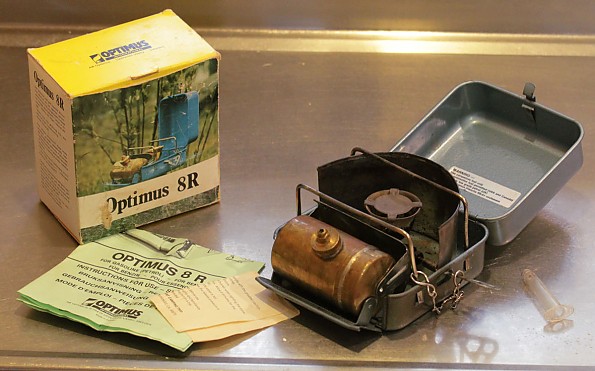
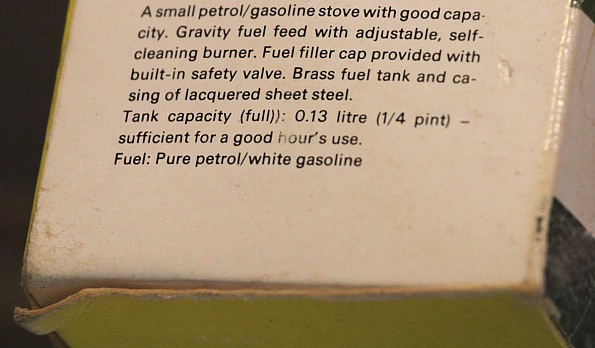

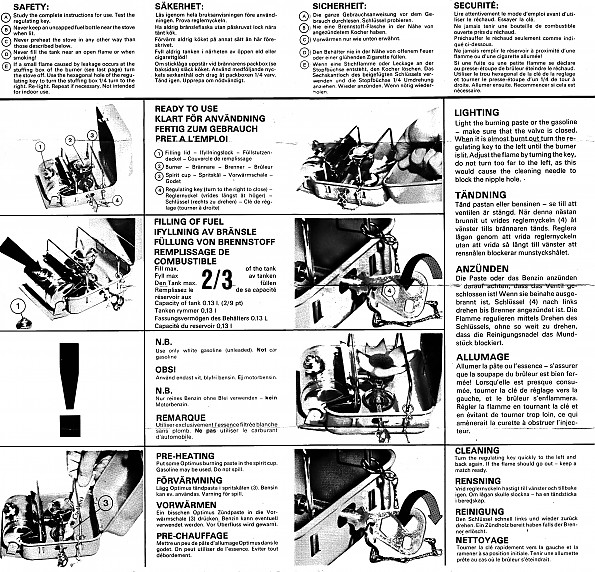

I include the instructions that came with the unit, for anyone out there that may find them useful.
To prime the unit, I use the shell of an old de-needled syringe that I dip in the tank, place my finger over the hole in the top of the syringe hole to extract the Fuelite, place this in the priming bowl. This can be done without spilling a drop. It can be difficult to know exactly how much fuel is in the tank though—one drawback.
The unit is a little louder than the modern canister stoves, it certainly sounds like it's burning some fuel. I've found the thing a little trooper. Doesn't leak fuel when being carried, packs away easily, is stable being lower than the canister style stoves.
Early on I made a little sheet steel wind break around the burner head to retain the heat.
The unit simmers fine, but I don't find the adjuster terribly progressive, a bit on/offy.
Just back from a week's hiking, never burned the rice or porridge.
I won't be replacing it any time soon.
Source: bought it new
Price Paid: ??
Quality, heavy, bullet proof.
Pros
- Bullet proof, like for real
- Self cleaning
- Simmered well
Cons
- Heavy
- Quite heavy
- Could have used a larger tank
This stove during its glory days should probably have deserved a four-star rating. Now days with lightweight liquid fuel stoves common, it takes a hit of a star. Fond nostalgia puts a half star back.
This was the first liquid fuel stove I ever owned and I agonized long and hard before making the choice.
The deciding factor was a simple one. I wanted a stove that sat low to the ground and was stable under every possible condition. I feared that the more common Svea 123 would be tippy in use if the ground was uneven. This stove certainly was stable. It would be an effort to kick it over.
It was good on gas, even parsimonious. I never found it hard to light, even before I added a pump too late in the game to matter.
In college I often burned auto fuel in the thing for lack of available stove fuel. It worked and did not even clog, although the built-in cleaning needle might have had something to do with that.
However...it was heavy, but I mean HEAVY. Why in God's name did they not make the box out of aluminum or design it in such a way that you could remove the works? Or even just a way to remove the lid? (It never occurred to me to simply remove the lid. I did after all carry it in a plastic bag. However I did in one demented moment remove a triangle of metal from the side of the box. This may have reduced the weight by as much as .75 oz.) This stove was significantly heavier than its main competitor the Svea 123.
However after some years I pried loose the money for a discounted display model of a newly appeared and much heralded MSR-G. At the time, it was a radically new departure from stoves like the 8R and the Svea 123. I felt like I was traveling feather-light. I would have long ago gotten rid of this old friend but for the nostalgia. Just writing this has brought a smile to my face remembering the many expeditions I carried it on.
Maybe I will give it to a friend for his get-home-alive kit.
Source: bought it new
Price Paid: unknown
Made to last. Almost no moving parts. Simple to use.
Pros
- Packs beautifully in its case, nothing to assemble. This is a big deal when it's cold outside and you have gloves.
- Easy to prime and start when you know how.
- No pump or other unreliable moving parts
Cons
- A bit heavy by today's standards, but not really.


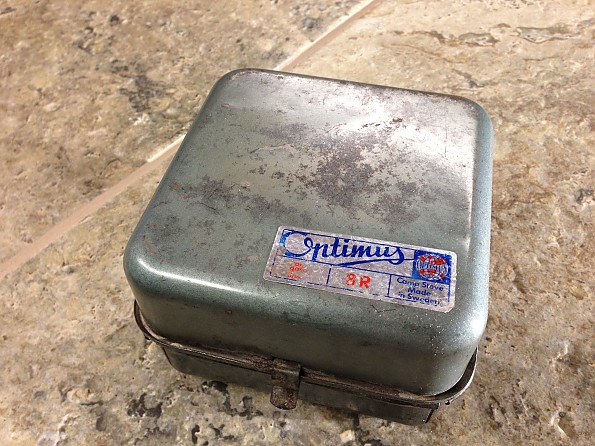
This was my first backpacking stove. My wife found it new in the box at a garage sale for $5 back in the 1980s. Camped with it from the Colorado Rockies to the hills of Pennsylvania.
I didn't fully understand the stove in the old days and I wasn't the best at starting it, but it always worked. Now that I understand it it is easy—thank you, internet. I always use alcohol now in the priming cup. Just don't try to start it too early before the prime has heated it up or you will have a fireball burning liquid fuel. But my WhisperLite was the same and that died an unhappy death when the rebuild kit failed to rescue the crappy pump.
People complain the 8R is heavy by a few grams. What a joke, most of the people complaining probably are carrying 20 extra pounds of fat on their belly. I completely cleaned the stove from my earlier abuses and replaced some parts, seals, and wick.
The stove will now outlast me since I am old and will be lucky to last 20 more years. The stove will have a different owner, but it will still be making coffee and rice for someone.
Source: received it as a personal gift
Bullet proof and it will SIMMER! Easy to light.
Pros
- No pumping
- Very stable base
- Easy to light
- No empty butane canisters to deal with
Cons
- Not the lightest or most compact stove
- Not the highest heat output
- Fuel tank on the small side
I have 2 of these, both purchased on eBay. They both work great and are easy to light. I prefer priming with alcohol as it prevents the excitement if over primed! The down side to that is the flame is hard to see in the daylight.
They provide quite sufficient heat for all my cooking and most importantly for me, they will simmer which fits my type of trail food. The base is quite stable being 4" by 4" and a flat 16 sq. in. surface.
I haven't timed the boil times but then again, I'm in no rush when I'm out enjoying the great outdoors! I think they're rated at 4700 BTU's. It's much more important to me to be able to simmer than how quickly I can boil water!
The fuel tank is on the small side but I carry a small fuel bottle for extra fuel. I also use a small filtered funnel.
There are smaller and lighter stoves available but these are so reliable that when the chips are down and you're really counting on a hot meal/drink, these will NOT fail you. No need to carry empty butane cartridges around and no recycling issues either.
I do have the pump and special fuel cap for that, but only use it when the temp gets very cold. Insulate it from cold ground or snow.
Source: bought it used
Price Paid: varies, have 2 of them
Bought mine in the '70s, ancient times now, backpacked all over the U.S. Fell down a steep ridge once, stove and extra fuel bottle took a few dents.
Just started it and ran it after 25 years of not using it. Started right up, even had old fuel. Great stove, just a little heavy compared to an MSR system.
Pros
- Very durable, compact, and impact resistant and tested in a fall
- Still works 25 years after it was used, so reliable
Cons
- Extra weight compared to light versions like MSR
No priming in colder weather, use some lighter paste or some petroleum jelly with a teaspoon of fuel in bottom of pan to get her rolling.
I say her because she has never let me down even in frozen conditions ice fishing.
Sorry, never tested efficiency or wind, but rain and cold no problem.
Wind usually out of the way with shelter, always used backpacking dried food, just add water, heat, and eat. Cooked a few fish, fried nice but temps were in the mid 50s.
Bought the stove because of durable container, much heavier than I wanted .
Glad I had it when I fell down a steep ridge, a few bangs and dents in case, good to go.
Source: bought it new
Price Paid: ?
I bought this from REI in 1969, befor my first tour in Vietnam. It went back for my second tour. All the time overseas it ran on Army MOGAS. It never faltered, even once. I heated tons of C-rat, PX chili, and gallons of coffee. I still have it, but it looks like it has been through a war. It has. It still works. Same burner setup like the SEAVA 123. Dead simple—only two moving parts. Anyplace that has motor scooters will have fuel.
Pros
- Dead nuts reliable
Cons
- Noisy, sounds like a rocket taking off. However Google silent burner for an 8r, the noise will go away. A bit pricy, but for me worth it.
- BTW I saw gas for under $3.00/ gal. Compared to Crown fuel at $15/gal.
Gosh,
Two tours in Vietname, one in Germany, a zillion motorcycle camps. I carry a quart can of fuel, good for week +.
In Vietnam rubbing alcohol wasn't available, so I used Zippo lighter fluid for priming. Army gas smoked in an open flame, so the lighter fluid worked fine.
Background
Used it since 1969.
Source: Got it from REI, when they had one store in SEATTLE.
The sturdiest and most dependable ever!
Pros
- Absolutely dependable, indestructible and versatile.
Cons
- Quite a chunk.
I bought mine new in 1977 with the pressure cap and pump. The pump makes a huge difference.
I have used it many hundreds of times and in every condition. Temps as low as -22°F and as high as 122°F and altitudes as high as 13,500 feet. It has never failed me!
The pressure cap allows two great improvements. By pumping the tank before firing it will self prime. Just open the valve for a couple of seconds will fill the priming cup. Turn the valve off and light. Reopen after it starts to hiss and before the flame goes out and it will take off. It will boil a liter in <4 minutes, and turn down down to a fine simmer. Needless to say the iron safe of a box will protect it against hammer blows.
The only drawbacks (especially as I get older) are the weight and the size. You have to carry a fuel bottle and between the two you're into about 3 pounds. It also eats up space in your pack.
I will leave this thing to the next couple of generations.
Source: bought it new
Price Paid: ~$40 (1977)
Small, light, and works every time.
Pros
- It has always worked
Cons
- A little hard to light in the wind. May need to
- contain the heat somehow in windy conditions.
I use this to make coffee in my shop. I found it in a thrift shop for $3.50 All it needed was a little cleaning and works perfect. I have two other ones, a 99 and a 111B. I think this one burns and simmers the best.
I have used this stove several times when airplane camping. It has become part of my small camping kit for overnight trips. I have cooked eggs, ham, rice, noodles...and other simple foods and it works perfect.
In a pinch I am sure I could burn avgas in it, but I have not tried it.
I have also used it to take the chill off my 4-season tent when camping in cold weather. I know that is not approved.
It lives in the emergency kit in the back of my bush plane. I don't go anywhere without it.
Source: bought it used
Price Paid: $3.50
42+ years old, and the 8R still works.
Pros
- Durable
- Stable
- Low profile
Cons
- Heavier than some
- No integral winscreen
My Primus 8R was a Christmas gift to my late father when he was Scoutmaster for my Boy Scout Troop. It performed admirably on many campouts and backpacking trips, most notably when Dad and I hiked the Chilkoot Pass gold rush trail from Alaska into British Columbia in 1972.
I also used it in the field when I was in the Army Artillery.
Recently I pulled it out, filled with fresh Coleman fuel, and fired it up. It doesn't seem to "roar" as loud as I remember, but I'm not about to toss it.
Any ideas on how to refurbish this great old stove? If so, I can be reached at wyomech2003@yahoo.com.
Source: bought it new
Price Paid: I don't remember...was bought in about 1970??
Best small stove for absolute reliability, operates under any conditions, indestructible...
Pros
- Best ever small stove, army tank construction
- Folds into small package, no assembly
- No loose parts
Cons
- Can't think of any
Have my original from 1972, never has let me down. Purchased new from K-Mart in Atlanta for (I think) $13.50. Always have used Coleman fuel, never has needed cleaning.
Store clerk said to prime by holding hands around tank, open valve a little , close and light the fuel in priming tray, then open valve; this has always worked hundreds of times. Always has interested observers when car camping—take small box out of car with food, stove and coffee/cooking pot and start.
Background
Almost 50 years with the same stove, no repairs needed
Source: bought it new
Great backpacking stove.
Pros
- Rugged
- Compact
- Efficient
Cons
- Requires a flat spot for stability
In the highlands of Lesotho I found the mini pressurising pump I had bought resulted in better performance. It also allows you to push some fuel out into the preheating cup with less fiddling than dribbling from a separate canister
I also have the larger kerosene (diesel) version of this stove which I use as a backup on my continued 4X4 bush trips in Africa. It needs a more volatile fuel for preheating, which is a bit of a pain
Remembering to actuate the jet cleaning pin at the end of use prevents clogging.
Background
I bought one of these in the mid-1970s and carried it around southern Africa. Coleman "white" gas was impossible to find so I just used petrol (gasoline) which was a bit smoky but worked fine
The tank retainer bracket broke its spot welds after some misadventure, but in Botswana I managed to find a firm making office furniture who had a suitable welder and they fixed it for me (free) in a few minutes. I repainted the cover eventually.
Source: bought it new
Price Paid: CDN$20
I bought my 8R in the mid-seventies new from REI when I became a member. I haven't used it in years, but recently dusted it off to use it and see that the fuel bowl used for priming is missing. Any ideas on where I might find one?
Pros
- Very reliable
Cons
- None
Very handy little stove that I used in the seventies and eighties. Wait a second...I'm pretty sure I'm not that old!
Background
I used this little stove extensively when I was in my teens and twenties. I love that little stove!
Source: bought it new
Been cooking since the '70s with no signs of stopping! Classic stove.
Pros
- Indestructible
- Runs on lots of fuels
Cons
- Really heavy by today's standards
What an epic stove. My dad handed this down to me and I may end up handing it down again. it shows no sign of stopping. The Swedes knew what they were doing!
I made a windscreen by cutting up a big soda can and wedging it in. Only thing is it's a hefty little thing.
Source: received it as a personal gift
I have two of these stove and find them terrific for simmering and boiling. The fuel capacity is a tad limited compared to the Svea 123 and it does not seem to burn as hot, though we are talking about maybe a 30 second delay in boil time.
It is very compact and dependable. I use the small pump prior to priming to assure easy lighting. I keep them in my cars in the event of an emergency away from home and day hikes.
Given a choice, I would say the Svea 123 is a tad better. If I am in need, the 8R is always there for us.
Price Paid: $40 used for each
I bought one when I was an Airborne Infantry officer. I carried it many miles--used it many times and it never failed.
It burned Army gas. One trick that I used was to carry a small spoon with half the handle cut off. I poured a little gas into the burner and lighted it to get the stove a little kick start--as you know, the stove has no pump.
One more thing. I have melted lead with it.
Price Paid: $10
I have the identical stove. I love it. I love the vintage stuff as well. I have a base camp 2-burner stove that is a pump up Coleman. It works amazing for base camp.
I also have two vintage Coleman lanterns and I wouldn't trade any of them for anything... My family and I have just gotten back from camping and we loved every minute of our time spent outdoors.
Background
AMAZING
Source: They all came from garage sales
Indestructible—great for winter camping, fires every time. These little stoves outlive their owners. Getting harder to find.
About 7 minutes to boil, but worth the extra couple of minutes—so easy and no bad for the environment cartridges to dispose of.
Best climbing hiking travel stove ever—except maybe the 123. Very cool.
Price Paid: $100 new
One badassed little stove, simmers well, cooks every time with no complaint. Easy to work and pretty light too. And it all fits into this cool little blue box.
Price Paid: $35
Bought my first 8r in 1973. Took it and an MSR PocketRocket on a -4 degree search and rescue certification exam. My 8r was the only stove that lit. Bought a second 8r in 1988 in case the first 8 r failed me, but it never did. 50 years of reliable use from #1—don’t need to say more.
Pros
- Totally reliable in very cold weather
- No used cylinders to cart around
Cons
- 1/4 pt fuel = 1 hr. in attached tank. 8 min to boil 2 l. h 20. You get about 7-8 min. burns per attached tank. Carry extra fuel if you need to.
Coleman fuel is best. Don’t use regular gas. I store extra fuel in a proper fuel bottle.
Background
Camping and emt /sar / ski patrol since 1973.
Source: bought it new
Price Paid: Not much, new from REI in 1973.
Pros
- Durable
- Reliable
- Old as dirt and still works
Cons
- Is a bit heavy and finicky to prime
Was given to me from a good friend. Never failed. Slow to boil but works. Got a Peak canister stove and the 8r outdid the modern Peak stove. Totally indestructible.
Didn't get a manual, so if it stops working I won't be able to fix it. So sad. My son will get it when I venture on my last hike.
Source: received it as a personal gift
Your Review
You May Like
Specs
| Price |
Reviewers Paid: $3.50-$100.00 |




